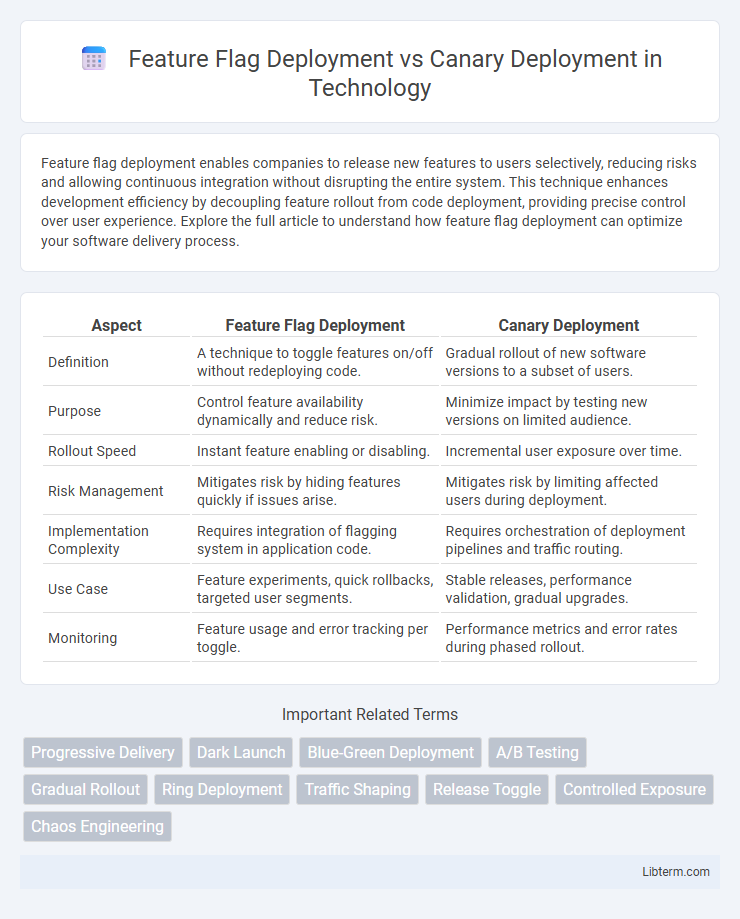Feature flag deployment enables companies to release new features to users selectively, reducing risks and allowing continuous integration without disrupting the entire system. This technique enhances development efficiency by decoupling feature rollout from code deployment, providing precise control over user experience. Explore the full article to understand how feature flag deployment can optimize your software delivery process.
Table of Comparison
| Aspect | Feature Flag Deployment | Canary Deployment |
|---|---|---|
| Definition | A technique to toggle features on/off without redeploying code. | Gradual rollout of new software versions to a subset of users. |
| Purpose | Control feature availability dynamically and reduce risk. | Minimize impact by testing new versions on limited audience. |
| Rollout Speed | Instant feature enabling or disabling. | Incremental user exposure over time. |
| Risk Management | Mitigates risk by hiding features quickly if issues arise. | Mitigates risk by limiting affected users during deployment. |
| Implementation Complexity | Requires integration of flagging system in application code. | Requires orchestration of deployment pipelines and traffic routing. |
| Use Case | Feature experiments, quick rollbacks, targeted user segments. | Stable releases, performance validation, gradual upgrades. |
| Monitoring | Feature usage and error tracking per toggle. | Performance metrics and error rates during phased rollout. |
Introduction to Feature Flag Deployment and Canary Deployment
Feature flag deployment enables controlled feature releases by toggling functionality on or off for specific user segments, allowing rapid testing and rollback without code redeployment. Canary deployment gradually rolls out new software versions to a subset of users, monitoring performance and errors before full-scale release. Both methods enhance release safety and minimize user impact during updates.
Defining Feature Flag Deployment
Feature Flag Deployment enables controlled feature releases by toggling functionality on or off for targeted user segments without code redeployment, enhancing continuous integration and delivery workflows. This technique decouples feature rollout from code deployment, allowing teams to perform A/B testing, gather user feedback, and mitigate risks associated with new releases. Prominent platforms like LaunchDarkly and FeatureToggle support feature flag management, ensuring scalable and dynamic feature control in complex production environments.
Understanding Canary Deployment
Canary deployment involves releasing a new software version to a small subset of users or servers while the rest continue using the previous version, enabling real-time monitoring and quick rollback if issues occur. This gradual rollout minimizes risks by isolating potential bugs or performance problems before full-scale deployment. Metrics such as error rates, latency, and user feedback guide the decision to proceed or halt the deployment, ensuring higher system stability and user experience.
Key Differences Between Feature Flags and Canary Releases
Feature flag deployment enables gradual feature activation for specific user segments, allowing precise control and instant rollback without redeploying code. Canary deployment involves releasing new software versions to a small subset of users or servers to monitor performance and detect issues before a full rollout. Key differences include feature flags controlling functionality activation independently of code deployment, while canary releases focus on progressive version rollout and system stability validation.
Benefits of Feature Flag Deployment
Feature Flag Deployment enables rapid feature rollout and rollback without redeploying code, reducing downtime and risk during software releases. This approach allows developers to target specific user segments or environments, facilitating controlled testing and gathering real-time feedback. It also enhances continuous delivery by decoupling feature release from code deployment, increasing agility and operational flexibility.
Advantages of Canary Deployment
Canary deployment minimizes risk by gradually releasing updates to a small subset of users, allowing developers to monitor system performance and detect issues before a full rollout. It enhances user experience through continuous delivery without downtime while providing the ability to quickly rollback if problems arise. This method also supports more accurate feedback collection from real-world use, optimizing stability and reliability in production environments.
Use Cases: When to Choose Feature Flags
Feature flag deployment is ideal for scenarios requiring rapid feature toggling, controlled experiments, and instant rollback without redeploying code, making it perfect for A/B testing and gradual feature rollouts. Enterprises use feature flags to decouple feature releases from code deployments, enabling teams to enable or disable functionalities in real time based on user feedback or system performance. This approach suits continuous delivery environments where minimizing risk and maintaining operational stability during feature introduction is critical.
Use Cases: When to Choose Canary Releases
Canary deployments are ideal for releasing updates to a small subset of users to monitor performance and detect issues before a full rollout, making them suitable for critical applications requiring high availability and minimal risk. They are commonly used when deploying backend services, infrastructure changes, or features with potential widespread impact to ensure stability without affecting the entire user base. Organizations choose canary releases when precise control over exposure and real-time performance metrics are essential for informed decision-making during deployment.
Challenges and Considerations for Each Approach
Feature flag deployment challenges include managing flag complexity and avoiding technical debt, which can lead to codebase clutter and increased maintenance efforts. Canary deployment considerations revolve around careful traffic segmentation and monitoring to minimize impact from failed updates, requiring robust infrastructure and real-time analytics. Both approaches demand rigorous testing and rollback strategies to ensure reliability and minimize user disruption during feature releases.
Best Practices for Modern Deployment Strategies
Feature flag deployment enables controlled feature releases by toggling functionality for specific user segments, minimizing risk and allowing instant rollback without full redeployment. Canary deployment gradually exposes new software versions to a small subset of users, monitoring performance and error rates to detect issues before wide release. Combining both strategies enhances deployment safety, with feature flags managing feature exposure while canaries validate stability, supporting continuous delivery and rapid iteration in modern DevOps environments.
Feature Flag Deployment Infographic

 libterm.com
libterm.com